Innovation and Commercialisation Report: Brainlabs Case Study
VerifiedAdded on 2020/06/03
|15
|4862
|349
Report
AI Summary
This report analyzes the significance of innovation within organizations, using Brainlabs, a UK-based digital media agency, as a case study. It explores the importance of innovation in driving social and economic development, particularly for Small and Medium Enterprises (SMEs). The report examines the different types of innovation, including product, process, and position, and their impact on a company's success. It also discusses the innovation mix model (Paradigm, Product, Process, Position) and its application to Brainlabs. Furthermore, the report delves into the commercialization process, including the ideation phase, business process stage, and stakeholder stage, integrating it with the New Product Development (NPD) process. The report highlights the importance of a structured approach to convert ideas into commercialized products or services, emphasizing the commercialization funnel and the stage-gate approach to NPD. The analysis aims to provide insights into how Brainlabs can enhance its innovation and commercialization strategies to maintain a competitive edge in the digital media market.

[INNOVATION & COMMERCIALISATION]
2018
2018
Paraphrase This Document
Need a fresh take? Get an instant paraphrase of this document with our AI Paraphraser

Contents
INTRODUCTION:....................................................................................................................................3
TASK 1:...................................................................................................................................................3
TASK 2....................................................................................................................................................5
Product..............................................................................................................................................5
Process..............................................................................................................................................6
Position..............................................................................................................................................6
TASK 3....................................................................................................................................................6
TASK 4....................................................................................................................................................9
REFERENCES........................................................................................................................................13
INTRODUCTION:....................................................................................................................................3
TASK 1:...................................................................................................................................................3
TASK 2....................................................................................................................................................5
Product..............................................................................................................................................5
Process..............................................................................................................................................6
Position..............................................................................................................................................6
TASK 3....................................................................................................................................................6
TASK 4....................................................................................................................................................9
REFERENCES........................................................................................................................................13
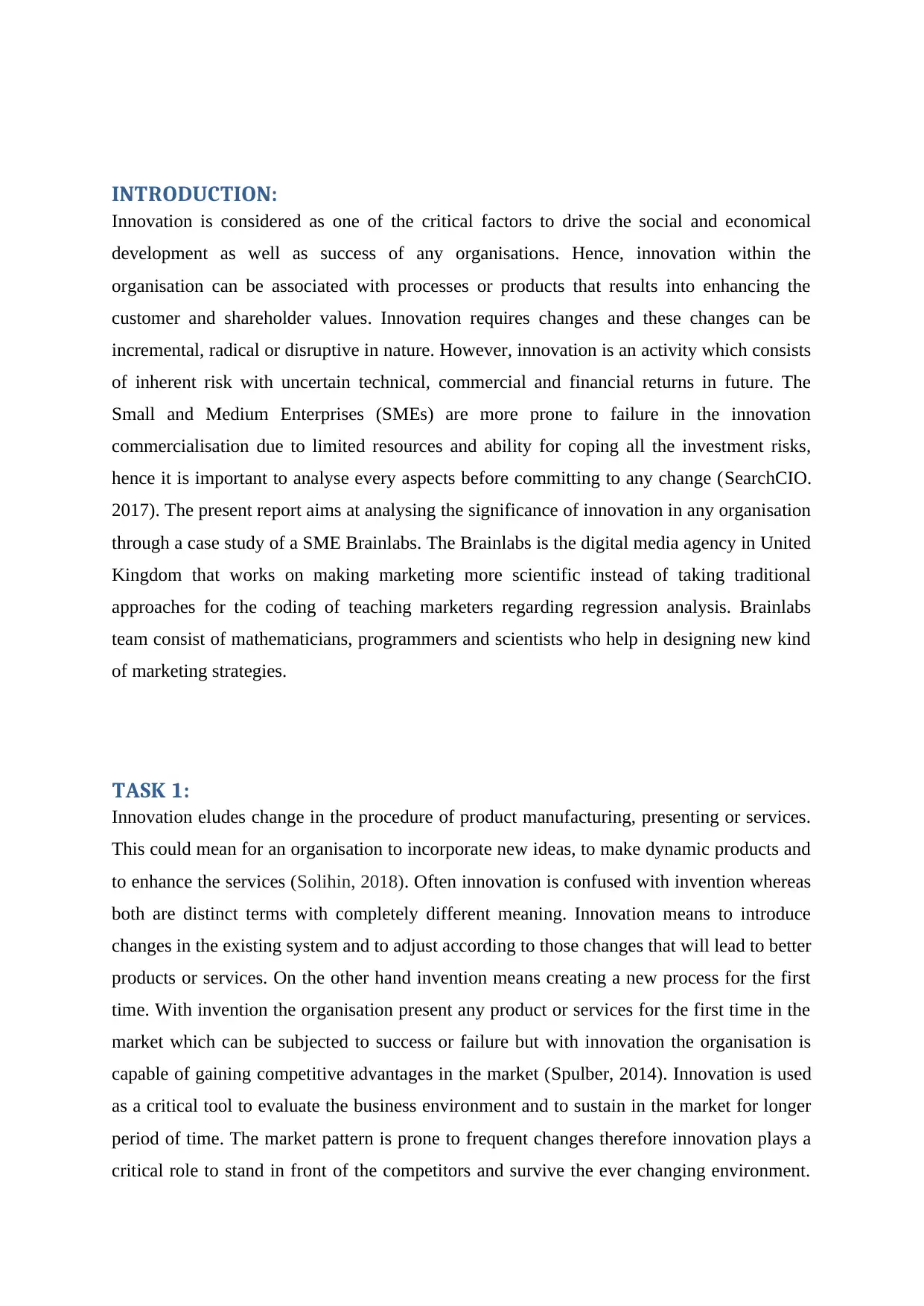
INTRODUCTION:
Innovation is considered as one of the critical factors to drive the social and economical
development as well as success of any organisations. Hence, innovation within the
organisation can be associated with processes or products that results into enhancing the
customer and shareholder values. Innovation requires changes and these changes can be
incremental, radical or disruptive in nature. However, innovation is an activity which consists
of inherent risk with uncertain technical, commercial and financial returns in future. The
Small and Medium Enterprises (SMEs) are more prone to failure in the innovation
commercialisation due to limited resources and ability for coping all the investment risks,
hence it is important to analyse every aspects before committing to any change (SearchCIO.
2017). The present report aims at analysing the significance of innovation in any organisation
through a case study of a SME Brainlabs. The Brainlabs is the digital media agency in United
Kingdom that works on making marketing more scientific instead of taking traditional
approaches for the coding of teaching marketers regarding regression analysis. Brainlabs
team consist of mathematicians, programmers and scientists who help in designing new kind
of marketing strategies.
TASK 1:
Innovation eludes change in the procedure of product manufacturing, presenting or services.
This could mean for an organisation to incorporate new ideas, to make dynamic products and
to enhance the services (Solihin, 2018). Often innovation is confused with invention whereas
both are distinct terms with completely different meaning. Innovation means to introduce
changes in the existing system and to adjust according to those changes that will lead to better
products or services. On the other hand invention means creating a new process for the first
time. With invention the organisation present any product or services for the first time in the
market which can be subjected to success or failure but with innovation the organisation is
capable of gaining competitive advantages in the market (Spulber, 2014). Innovation is used
as a critical tool to evaluate the business environment and to sustain in the market for longer
period of time. The market pattern is prone to frequent changes therefore innovation plays a
critical role to stand in front of the competitors and survive the ever changing environment.
Innovation is considered as one of the critical factors to drive the social and economical
development as well as success of any organisations. Hence, innovation within the
organisation can be associated with processes or products that results into enhancing the
customer and shareholder values. Innovation requires changes and these changes can be
incremental, radical or disruptive in nature. However, innovation is an activity which consists
of inherent risk with uncertain technical, commercial and financial returns in future. The
Small and Medium Enterprises (SMEs) are more prone to failure in the innovation
commercialisation due to limited resources and ability for coping all the investment risks,
hence it is important to analyse every aspects before committing to any change (SearchCIO.
2017). The present report aims at analysing the significance of innovation in any organisation
through a case study of a SME Brainlabs. The Brainlabs is the digital media agency in United
Kingdom that works on making marketing more scientific instead of taking traditional
approaches for the coding of teaching marketers regarding regression analysis. Brainlabs
team consist of mathematicians, programmers and scientists who help in designing new kind
of marketing strategies.
TASK 1:
Innovation eludes change in the procedure of product manufacturing, presenting or services.
This could mean for an organisation to incorporate new ideas, to make dynamic products and
to enhance the services (Solihin, 2018). Often innovation is confused with invention whereas
both are distinct terms with completely different meaning. Innovation means to introduce
changes in the existing system and to adjust according to those changes that will lead to better
products or services. On the other hand invention means creating a new process for the first
time. With invention the organisation present any product or services for the first time in the
market which can be subjected to success or failure but with innovation the organisation is
capable of gaining competitive advantages in the market (Spulber, 2014). Innovation is used
as a critical tool to evaluate the business environment and to sustain in the market for longer
period of time. The market pattern is prone to frequent changes therefore innovation plays a
critical role to stand in front of the competitors and survive the ever changing environment.
⊘ This is a preview!⊘
Do you want full access?
Subscribe today to unlock all pages.

Trusted by 1+ million students worldwide
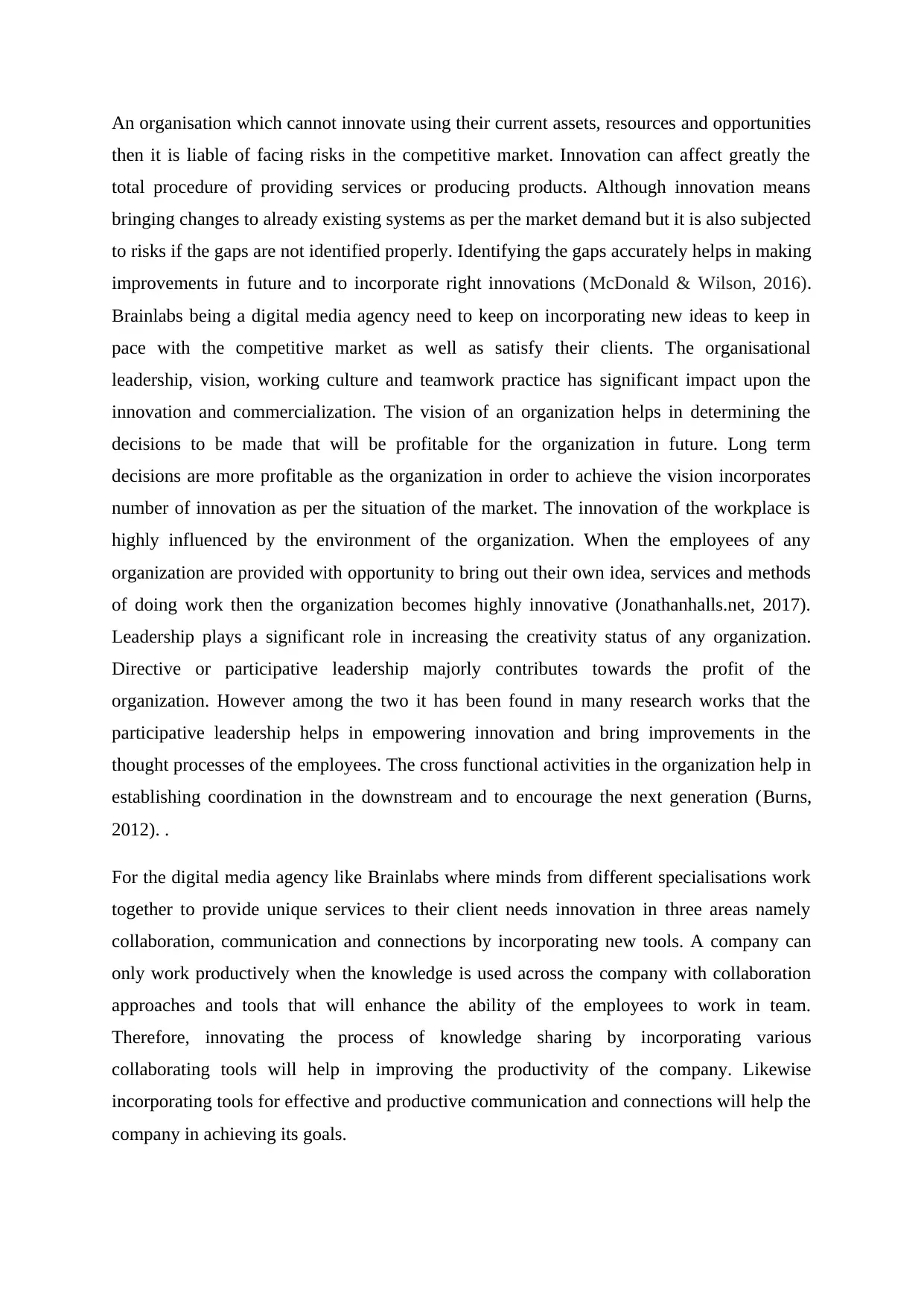
An organisation which cannot innovate using their current assets, resources and opportunities
then it is liable of facing risks in the competitive market. Innovation can affect greatly the
total procedure of providing services or producing products. Although innovation means
bringing changes to already existing systems as per the market demand but it is also subjected
to risks if the gaps are not identified properly. Identifying the gaps accurately helps in making
improvements in future and to incorporate right innovations (McDonald & Wilson, 2016).
Brainlabs being a digital media agency need to keep on incorporating new ideas to keep in
pace with the competitive market as well as satisfy their clients. The organisational
leadership, vision, working culture and teamwork practice has significant impact upon the
innovation and commercialization. The vision of an organization helps in determining the
decisions to be made that will be profitable for the organization in future. Long term
decisions are more profitable as the organization in order to achieve the vision incorporates
number of innovation as per the situation of the market. The innovation of the workplace is
highly influenced by the environment of the organization. When the employees of any
organization are provided with opportunity to bring out their own idea, services and methods
of doing work then the organization becomes highly innovative (Jonathanhalls.net, 2017).
Leadership plays a significant role in increasing the creativity status of any organization.
Directive or participative leadership majorly contributes towards the profit of the
organization. However among the two it has been found in many research works that the
participative leadership helps in empowering innovation and bring improvements in the
thought processes of the employees. The cross functional activities in the organization help in
establishing coordination in the downstream and to encourage the next generation (Burns,
2012). .
For the digital media agency like Brainlabs where minds from different specialisations work
together to provide unique services to their client needs innovation in three areas namely
collaboration, communication and connections by incorporating new tools. A company can
only work productively when the knowledge is used across the company with collaboration
approaches and tools that will enhance the ability of the employees to work in team.
Therefore, innovating the process of knowledge sharing by incorporating various
collaborating tools will help in improving the productivity of the company. Likewise
incorporating tools for effective and productive communication and connections will help the
company in achieving its goals.
then it is liable of facing risks in the competitive market. Innovation can affect greatly the
total procedure of providing services or producing products. Although innovation means
bringing changes to already existing systems as per the market demand but it is also subjected
to risks if the gaps are not identified properly. Identifying the gaps accurately helps in making
improvements in future and to incorporate right innovations (McDonald & Wilson, 2016).
Brainlabs being a digital media agency need to keep on incorporating new ideas to keep in
pace with the competitive market as well as satisfy their clients. The organisational
leadership, vision, working culture and teamwork practice has significant impact upon the
innovation and commercialization. The vision of an organization helps in determining the
decisions to be made that will be profitable for the organization in future. Long term
decisions are more profitable as the organization in order to achieve the vision incorporates
number of innovation as per the situation of the market. The innovation of the workplace is
highly influenced by the environment of the organization. When the employees of any
organization are provided with opportunity to bring out their own idea, services and methods
of doing work then the organization becomes highly innovative (Jonathanhalls.net, 2017).
Leadership plays a significant role in increasing the creativity status of any organization.
Directive or participative leadership majorly contributes towards the profit of the
organization. However among the two it has been found in many research works that the
participative leadership helps in empowering innovation and bring improvements in the
thought processes of the employees. The cross functional activities in the organization help in
establishing coordination in the downstream and to encourage the next generation (Burns,
2012). .
For the digital media agency like Brainlabs where minds from different specialisations work
together to provide unique services to their client needs innovation in three areas namely
collaboration, communication and connections by incorporating new tools. A company can
only work productively when the knowledge is used across the company with collaboration
approaches and tools that will enhance the ability of the employees to work in team.
Therefore, innovating the process of knowledge sharing by incorporating various
collaborating tools will help in improving the productivity of the company. Likewise
incorporating tools for effective and productive communication and connections will help the
company in achieving its goals.
Paraphrase This Document
Need a fresh take? Get an instant paraphrase of this document with our AI Paraphraser
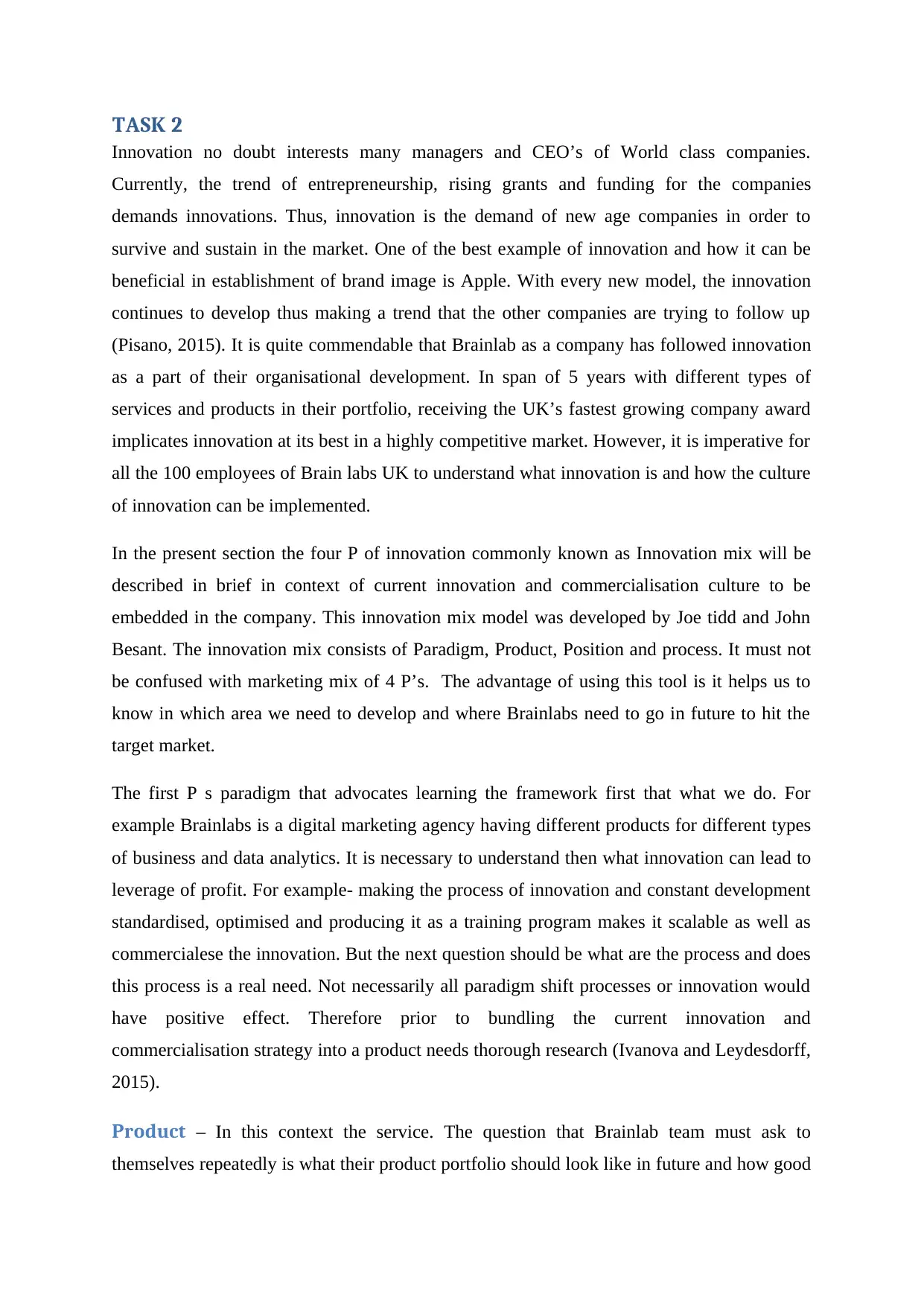
TASK 2
Innovation no doubt interests many managers and CEO’s of World class companies.
Currently, the trend of entrepreneurship, rising grants and funding for the companies
demands innovations. Thus, innovation is the demand of new age companies in order to
survive and sustain in the market. One of the best example of innovation and how it can be
beneficial in establishment of brand image is Apple. With every new model, the innovation
continues to develop thus making a trend that the other companies are trying to follow up
(Pisano, 2015). It is quite commendable that Brainlab as a company has followed innovation
as a part of their organisational development. In span of 5 years with different types of
services and products in their portfolio, receiving the UK’s fastest growing company award
implicates innovation at its best in a highly competitive market. However, it is imperative for
all the 100 employees of Brain labs UK to understand what innovation is and how the culture
of innovation can be implemented.
In the present section the four P of innovation commonly known as Innovation mix will be
described in brief in context of current innovation and commercialisation culture to be
embedded in the company. This innovation mix model was developed by Joe tidd and John
Besant. The innovation mix consists of Paradigm, Product, Position and process. It must not
be confused with marketing mix of 4 P’s. The advantage of using this tool is it helps us to
know in which area we need to develop and where Brainlabs need to go in future to hit the
target market.
The first P s paradigm that advocates learning the framework first that what we do. For
example Brainlabs is a digital marketing agency having different products for different types
of business and data analytics. It is necessary to understand then what innovation can lead to
leverage of profit. For example- making the process of innovation and constant development
standardised, optimised and producing it as a training program makes it scalable as well as
commercialese the innovation. But the next question should be what are the process and does
this process is a real need. Not necessarily all paradigm shift processes or innovation would
have positive effect. Therefore prior to bundling the current innovation and
commercialisation strategy into a product needs thorough research (Ivanova and Leydesdorff,
2015).
Product – In this context the service. The question that Brainlab team must ask to
themselves repeatedly is what their product portfolio should look like in future and how good
Innovation no doubt interests many managers and CEO’s of World class companies.
Currently, the trend of entrepreneurship, rising grants and funding for the companies
demands innovations. Thus, innovation is the demand of new age companies in order to
survive and sustain in the market. One of the best example of innovation and how it can be
beneficial in establishment of brand image is Apple. With every new model, the innovation
continues to develop thus making a trend that the other companies are trying to follow up
(Pisano, 2015). It is quite commendable that Brainlab as a company has followed innovation
as a part of their organisational development. In span of 5 years with different types of
services and products in their portfolio, receiving the UK’s fastest growing company award
implicates innovation at its best in a highly competitive market. However, it is imperative for
all the 100 employees of Brain labs UK to understand what innovation is and how the culture
of innovation can be implemented.
In the present section the four P of innovation commonly known as Innovation mix will be
described in brief in context of current innovation and commercialisation culture to be
embedded in the company. This innovation mix model was developed by Joe tidd and John
Besant. The innovation mix consists of Paradigm, Product, Position and process. It must not
be confused with marketing mix of 4 P’s. The advantage of using this tool is it helps us to
know in which area we need to develop and where Brainlabs need to go in future to hit the
target market.
The first P s paradigm that advocates learning the framework first that what we do. For
example Brainlabs is a digital marketing agency having different products for different types
of business and data analytics. It is necessary to understand then what innovation can lead to
leverage of profit. For example- making the process of innovation and constant development
standardised, optimised and producing it as a training program makes it scalable as well as
commercialese the innovation. But the next question should be what are the process and does
this process is a real need. Not necessarily all paradigm shift processes or innovation would
have positive effect. Therefore prior to bundling the current innovation and
commercialisation strategy into a product needs thorough research (Ivanova and Leydesdorff,
2015).
Product – In this context the service. The question that Brainlab team must ask to
themselves repeatedly is what their product portfolio should look like in future and how good
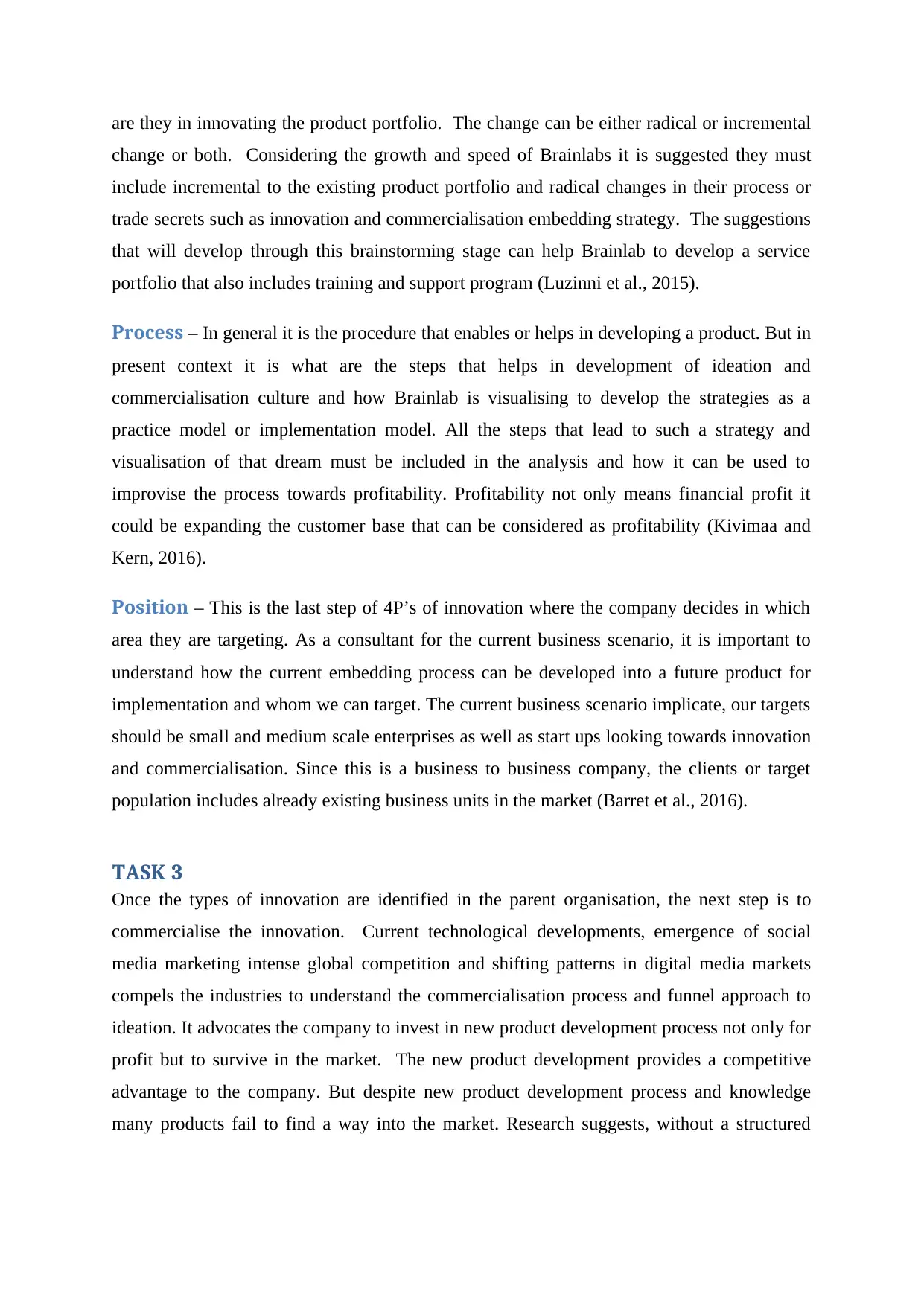
are they in innovating the product portfolio. The change can be either radical or incremental
change or both. Considering the growth and speed of Brainlabs it is suggested they must
include incremental to the existing product portfolio and radical changes in their process or
trade secrets such as innovation and commercialisation embedding strategy. The suggestions
that will develop through this brainstorming stage can help Brainlab to develop a service
portfolio that also includes training and support program (Luzinni et al., 2015).
Process – In general it is the procedure that enables or helps in developing a product. But in
present context it is what are the steps that helps in development of ideation and
commercialisation culture and how Brainlab is visualising to develop the strategies as a
practice model or implementation model. All the steps that lead to such a strategy and
visualisation of that dream must be included in the analysis and how it can be used to
improvise the process towards profitability. Profitability not only means financial profit it
could be expanding the customer base that can be considered as profitability (Kivimaa and
Kern, 2016).
Position – This is the last step of 4P’s of innovation where the company decides in which
area they are targeting. As a consultant for the current business scenario, it is important to
understand how the current embedding process can be developed into a future product for
implementation and whom we can target. The current business scenario implicate, our targets
should be small and medium scale enterprises as well as start ups looking towards innovation
and commercialisation. Since this is a business to business company, the clients or target
population includes already existing business units in the market (Barret et al., 2016).
TASK 3
Once the types of innovation are identified in the parent organisation, the next step is to
commercialise the innovation. Current technological developments, emergence of social
media marketing intense global competition and shifting patterns in digital media markets
compels the industries to understand the commercialisation process and funnel approach to
ideation. It advocates the company to invest in new product development process not only for
profit but to survive in the market. The new product development provides a competitive
advantage to the company. But despite new product development process and knowledge
many products fail to find a way into the market. Research suggests, without a structured
change or both. Considering the growth and speed of Brainlabs it is suggested they must
include incremental to the existing product portfolio and radical changes in their process or
trade secrets such as innovation and commercialisation embedding strategy. The suggestions
that will develop through this brainstorming stage can help Brainlab to develop a service
portfolio that also includes training and support program (Luzinni et al., 2015).
Process – In general it is the procedure that enables or helps in developing a product. But in
present context it is what are the steps that helps in development of ideation and
commercialisation culture and how Brainlab is visualising to develop the strategies as a
practice model or implementation model. All the steps that lead to such a strategy and
visualisation of that dream must be included in the analysis and how it can be used to
improvise the process towards profitability. Profitability not only means financial profit it
could be expanding the customer base that can be considered as profitability (Kivimaa and
Kern, 2016).
Position – This is the last step of 4P’s of innovation where the company decides in which
area they are targeting. As a consultant for the current business scenario, it is important to
understand how the current embedding process can be developed into a future product for
implementation and whom we can target. The current business scenario implicate, our targets
should be small and medium scale enterprises as well as start ups looking towards innovation
and commercialisation. Since this is a business to business company, the clients or target
population includes already existing business units in the market (Barret et al., 2016).
TASK 3
Once the types of innovation are identified in the parent organisation, the next step is to
commercialise the innovation. Current technological developments, emergence of social
media marketing intense global competition and shifting patterns in digital media markets
compels the industries to understand the commercialisation process and funnel approach to
ideation. It advocates the company to invest in new product development process not only for
profit but to survive in the market. The new product development provides a competitive
advantage to the company. But despite new product development process and knowledge
many products fail to find a way into the market. Research suggests, without a structured
⊘ This is a preview!⊘
Do you want full access?
Subscribe today to unlock all pages.

Trusted by 1+ million students worldwide
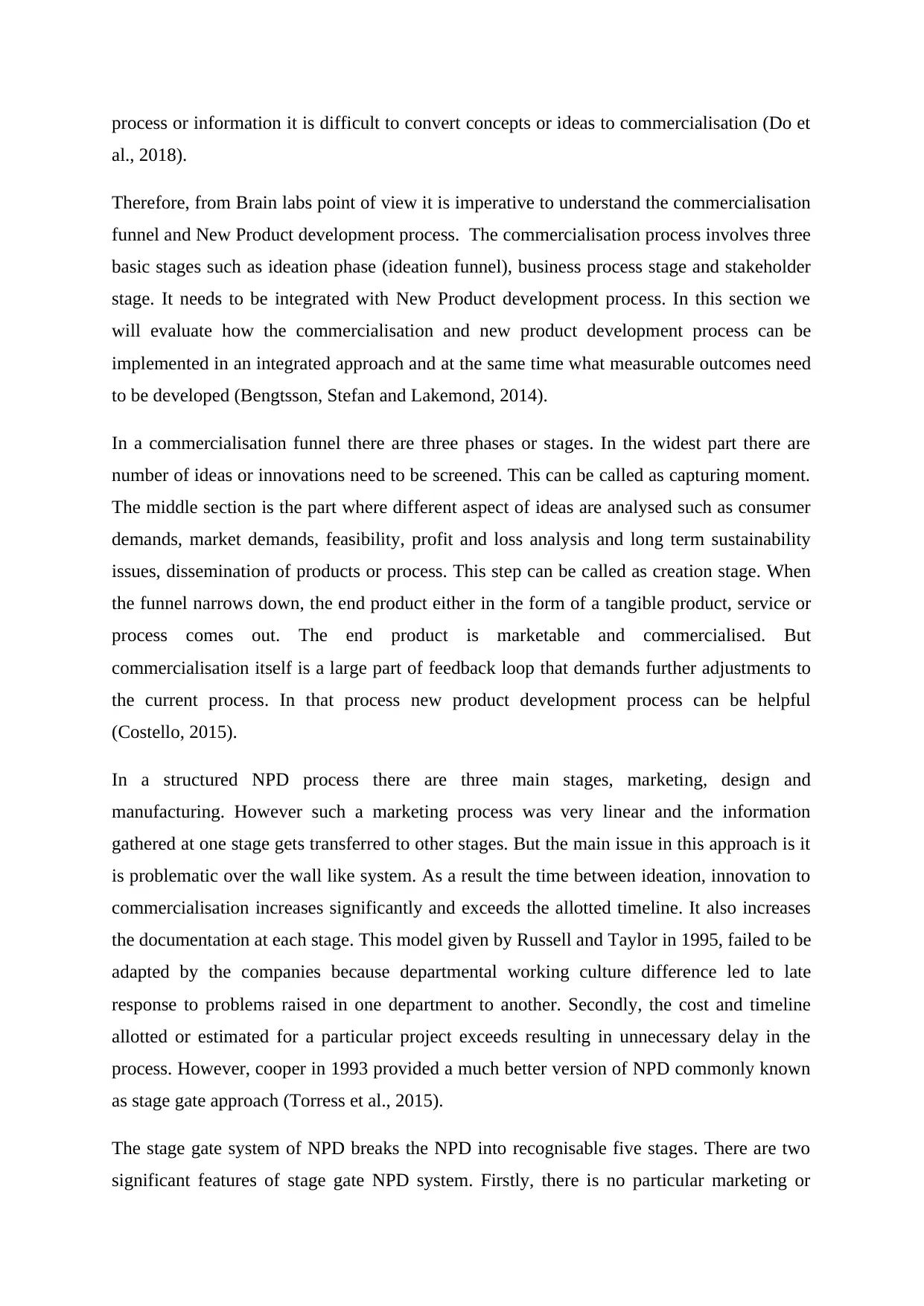
process or information it is difficult to convert concepts or ideas to commercialisation (Do et
al., 2018).
Therefore, from Brain labs point of view it is imperative to understand the commercialisation
funnel and New Product development process. The commercialisation process involves three
basic stages such as ideation phase (ideation funnel), business process stage and stakeholder
stage. It needs to be integrated with New Product development process. In this section we
will evaluate how the commercialisation and new product development process can be
implemented in an integrated approach and at the same time what measurable outcomes need
to be developed (Bengtsson, Stefan and Lakemond, 2014).
In a commercialisation funnel there are three phases or stages. In the widest part there are
number of ideas or innovations need to be screened. This can be called as capturing moment.
The middle section is the part where different aspect of ideas are analysed such as consumer
demands, market demands, feasibility, profit and loss analysis and long term sustainability
issues, dissemination of products or process. This step can be called as creation stage. When
the funnel narrows down, the end product either in the form of a tangible product, service or
process comes out. The end product is marketable and commercialised. But
commercialisation itself is a large part of feedback loop that demands further adjustments to
the current process. In that process new product development process can be helpful
(Costello, 2015).
In a structured NPD process there are three main stages, marketing, design and
manufacturing. However such a marketing process was very linear and the information
gathered at one stage gets transferred to other stages. But the main issue in this approach is it
is problematic over the wall like system. As a result the time between ideation, innovation to
commercialisation increases significantly and exceeds the allotted timeline. It also increases
the documentation at each stage. This model given by Russell and Taylor in 1995, failed to be
adapted by the companies because departmental working culture difference led to late
response to problems raised in one department to another. Secondly, the cost and timeline
allotted or estimated for a particular project exceeds resulting in unnecessary delay in the
process. However, cooper in 1993 provided a much better version of NPD commonly known
as stage gate approach (Torress et al., 2015).
The stage gate system of NPD breaks the NPD into recognisable five stages. There are two
significant features of stage gate NPD system. Firstly, there is no particular marketing or
al., 2018).
Therefore, from Brain labs point of view it is imperative to understand the commercialisation
funnel and New Product development process. The commercialisation process involves three
basic stages such as ideation phase (ideation funnel), business process stage and stakeholder
stage. It needs to be integrated with New Product development process. In this section we
will evaluate how the commercialisation and new product development process can be
implemented in an integrated approach and at the same time what measurable outcomes need
to be developed (Bengtsson, Stefan and Lakemond, 2014).
In a commercialisation funnel there are three phases or stages. In the widest part there are
number of ideas or innovations need to be screened. This can be called as capturing moment.
The middle section is the part where different aspect of ideas are analysed such as consumer
demands, market demands, feasibility, profit and loss analysis and long term sustainability
issues, dissemination of products or process. This step can be called as creation stage. When
the funnel narrows down, the end product either in the form of a tangible product, service or
process comes out. The end product is marketable and commercialised. But
commercialisation itself is a large part of feedback loop that demands further adjustments to
the current process. In that process new product development process can be helpful
(Costello, 2015).
In a structured NPD process there are three main stages, marketing, design and
manufacturing. However such a marketing process was very linear and the information
gathered at one stage gets transferred to other stages. But the main issue in this approach is it
is problematic over the wall like system. As a result the time between ideation, innovation to
commercialisation increases significantly and exceeds the allotted timeline. It also increases
the documentation at each stage. This model given by Russell and Taylor in 1995, failed to be
adapted by the companies because departmental working culture difference led to late
response to problems raised in one department to another. Secondly, the cost and timeline
allotted or estimated for a particular project exceeds resulting in unnecessary delay in the
process. However, cooper in 1993 provided a much better version of NPD commonly known
as stage gate approach (Torress et al., 2015).
The stage gate system of NPD breaks the NPD into recognisable five stages. There are two
significant features of stage gate NPD system. Firstly, there is no particular marketing or
Paraphrase This Document
Need a fresh take? Get an instant paraphrase of this document with our AI Paraphraser
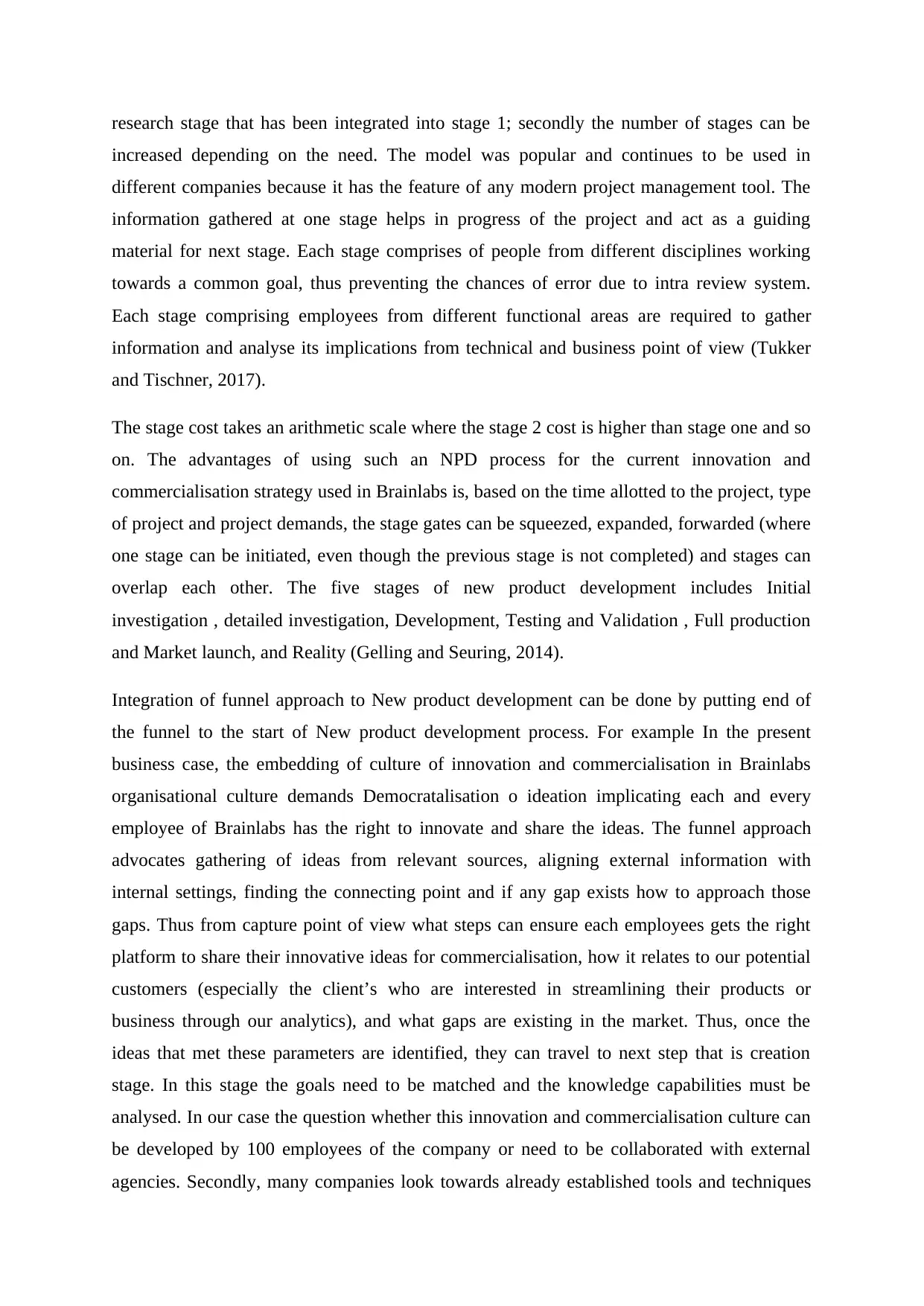
research stage that has been integrated into stage 1; secondly the number of stages can be
increased depending on the need. The model was popular and continues to be used in
different companies because it has the feature of any modern project management tool. The
information gathered at one stage helps in progress of the project and act as a guiding
material for next stage. Each stage comprises of people from different disciplines working
towards a common goal, thus preventing the chances of error due to intra review system.
Each stage comprising employees from different functional areas are required to gather
information and analyse its implications from technical and business point of view (Tukker
and Tischner, 2017).
The stage cost takes an arithmetic scale where the stage 2 cost is higher than stage one and so
on. The advantages of using such an NPD process for the current innovation and
commercialisation strategy used in Brainlabs is, based on the time allotted to the project, type
of project and project demands, the stage gates can be squeezed, expanded, forwarded (where
one stage can be initiated, even though the previous stage is not completed) and stages can
overlap each other. The five stages of new product development includes Initial
investigation , detailed investigation, Development, Testing and Validation , Full production
and Market launch, and Reality (Gelling and Seuring, 2014).
Integration of funnel approach to New product development can be done by putting end of
the funnel to the start of New product development process. For example In the present
business case, the embedding of culture of innovation and commercialisation in Brainlabs
organisational culture demands Democratalisation o ideation implicating each and every
employee of Brainlabs has the right to innovate and share the ideas. The funnel approach
advocates gathering of ideas from relevant sources, aligning external information with
internal settings, finding the connecting point and if any gap exists how to approach those
gaps. Thus from capture point of view what steps can ensure each employees gets the right
platform to share their innovative ideas for commercialisation, how it relates to our potential
customers (especially the client’s who are interested in streamlining their products or
business through our analytics), and what gaps are existing in the market. Thus, once the
ideas that met these parameters are identified, they can travel to next step that is creation
stage. In this stage the goals need to be matched and the knowledge capabilities must be
analysed. In our case the question whether this innovation and commercialisation culture can
be developed by 100 employees of the company or need to be collaborated with external
agencies. Secondly, many companies look towards already established tools and techniques
increased depending on the need. The model was popular and continues to be used in
different companies because it has the feature of any modern project management tool. The
information gathered at one stage helps in progress of the project and act as a guiding
material for next stage. Each stage comprises of people from different disciplines working
towards a common goal, thus preventing the chances of error due to intra review system.
Each stage comprising employees from different functional areas are required to gather
information and analyse its implications from technical and business point of view (Tukker
and Tischner, 2017).
The stage cost takes an arithmetic scale where the stage 2 cost is higher than stage one and so
on. The advantages of using such an NPD process for the current innovation and
commercialisation strategy used in Brainlabs is, based on the time allotted to the project, type
of project and project demands, the stage gates can be squeezed, expanded, forwarded (where
one stage can be initiated, even though the previous stage is not completed) and stages can
overlap each other. The five stages of new product development includes Initial
investigation , detailed investigation, Development, Testing and Validation , Full production
and Market launch, and Reality (Gelling and Seuring, 2014).
Integration of funnel approach to New product development can be done by putting end of
the funnel to the start of New product development process. For example In the present
business case, the embedding of culture of innovation and commercialisation in Brainlabs
organisational culture demands Democratalisation o ideation implicating each and every
employee of Brainlabs has the right to innovate and share the ideas. The funnel approach
advocates gathering of ideas from relevant sources, aligning external information with
internal settings, finding the connecting point and if any gap exists how to approach those
gaps. Thus from capture point of view what steps can ensure each employees gets the right
platform to share their innovative ideas for commercialisation, how it relates to our potential
customers (especially the client’s who are interested in streamlining their products or
business through our analytics), and what gaps are existing in the market. Thus, once the
ideas that met these parameters are identified, they can travel to next step that is creation
stage. In this stage the goals need to be matched and the knowledge capabilities must be
analysed. In our case the question whether this innovation and commercialisation culture can
be developed by 100 employees of the company or need to be collaborated with external
agencies. Secondly, many companies look towards already established tools and techniques
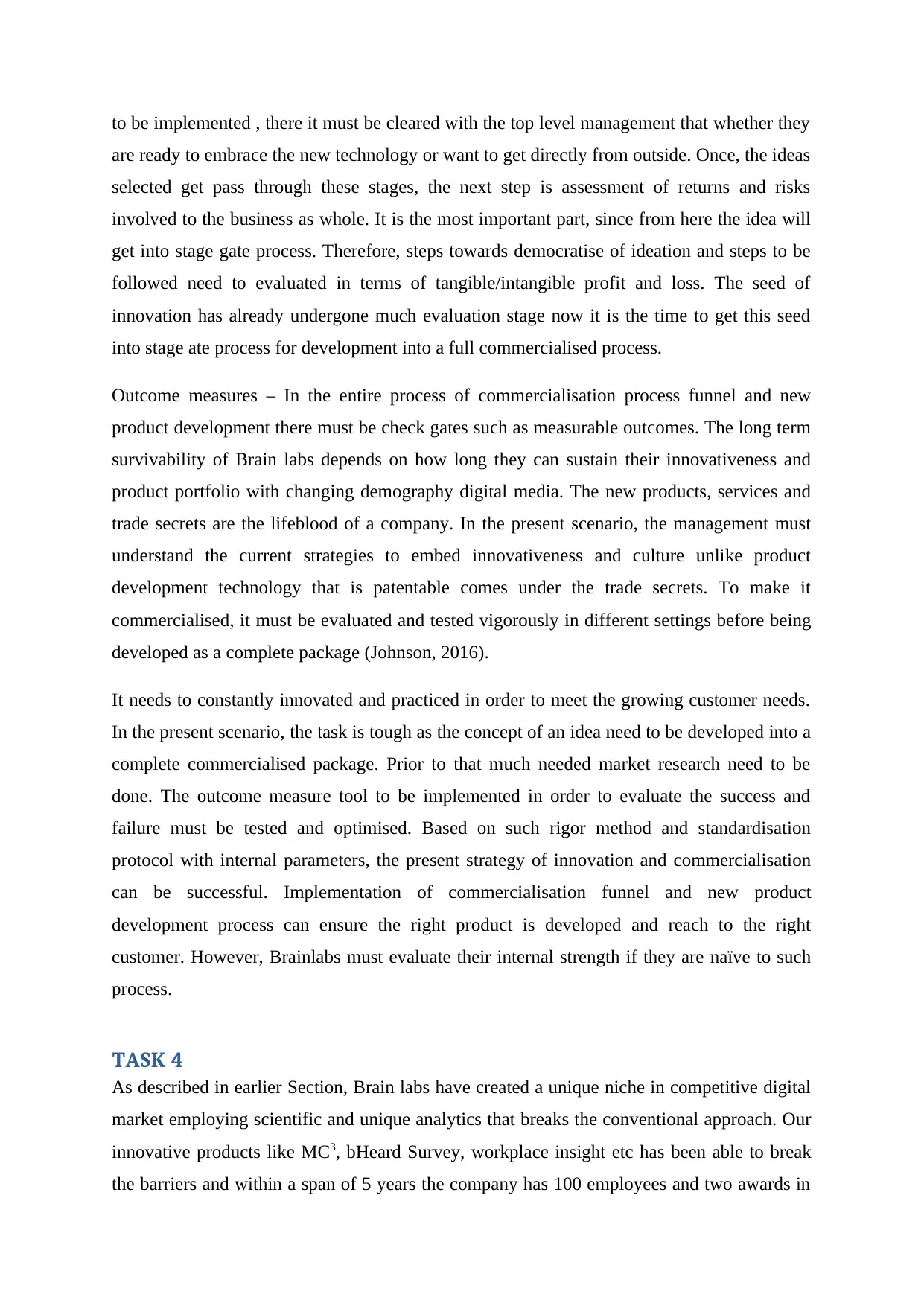
to be implemented , there it must be cleared with the top level management that whether they
are ready to embrace the new technology or want to get directly from outside. Once, the ideas
selected get pass through these stages, the next step is assessment of returns and risks
involved to the business as whole. It is the most important part, since from here the idea will
get into stage gate process. Therefore, steps towards democratise of ideation and steps to be
followed need to evaluated in terms of tangible/intangible profit and loss. The seed of
innovation has already undergone much evaluation stage now it is the time to get this seed
into stage ate process for development into a full commercialised process.
Outcome measures – In the entire process of commercialisation process funnel and new
product development there must be check gates such as measurable outcomes. The long term
survivability of Brain labs depends on how long they can sustain their innovativeness and
product portfolio with changing demography digital media. The new products, services and
trade secrets are the lifeblood of a company. In the present scenario, the management must
understand the current strategies to embed innovativeness and culture unlike product
development technology that is patentable comes under the trade secrets. To make it
commercialised, it must be evaluated and tested vigorously in different settings before being
developed as a complete package (Johnson, 2016).
It needs to constantly innovated and practiced in order to meet the growing customer needs.
In the present scenario, the task is tough as the concept of an idea need to be developed into a
complete commercialised package. Prior to that much needed market research need to be
done. The outcome measure tool to be implemented in order to evaluate the success and
failure must be tested and optimised. Based on such rigor method and standardisation
protocol with internal parameters, the present strategy of innovation and commercialisation
can be successful. Implementation of commercialisation funnel and new product
development process can ensure the right product is developed and reach to the right
customer. However, Brainlabs must evaluate their internal strength if they are naïve to such
process.
TASK 4
As described in earlier Section, Brain labs have created a unique niche in competitive digital
market employing scientific and unique analytics that breaks the conventional approach. Our
innovative products like MC3, bHeard Survey, workplace insight etc has been able to break
the barriers and within a span of 5 years the company has 100 employees and two awards in
are ready to embrace the new technology or want to get directly from outside. Once, the ideas
selected get pass through these stages, the next step is assessment of returns and risks
involved to the business as whole. It is the most important part, since from here the idea will
get into stage gate process. Therefore, steps towards democratise of ideation and steps to be
followed need to evaluated in terms of tangible/intangible profit and loss. The seed of
innovation has already undergone much evaluation stage now it is the time to get this seed
into stage ate process for development into a full commercialised process.
Outcome measures – In the entire process of commercialisation process funnel and new
product development there must be check gates such as measurable outcomes. The long term
survivability of Brain labs depends on how long they can sustain their innovativeness and
product portfolio with changing demography digital media. The new products, services and
trade secrets are the lifeblood of a company. In the present scenario, the management must
understand the current strategies to embed innovativeness and culture unlike product
development technology that is patentable comes under the trade secrets. To make it
commercialised, it must be evaluated and tested vigorously in different settings before being
developed as a complete package (Johnson, 2016).
It needs to constantly innovated and practiced in order to meet the growing customer needs.
In the present scenario, the task is tough as the concept of an idea need to be developed into a
complete commercialised package. Prior to that much needed market research need to be
done. The outcome measure tool to be implemented in order to evaluate the success and
failure must be tested and optimised. Based on such rigor method and standardisation
protocol with internal parameters, the present strategy of innovation and commercialisation
can be successful. Implementation of commercialisation funnel and new product
development process can ensure the right product is developed and reach to the right
customer. However, Brainlabs must evaluate their internal strength if they are naïve to such
process.
TASK 4
As described in earlier Section, Brain labs have created a unique niche in competitive digital
market employing scientific and unique analytics that breaks the conventional approach. Our
innovative products like MC3, bHeard Survey, workplace insight etc has been able to break
the barriers and within a span of 5 years the company has 100 employees and two awards in
⊘ This is a preview!⊘
Do you want full access?
Subscribe today to unlock all pages.

Trusted by 1+ million students worldwide
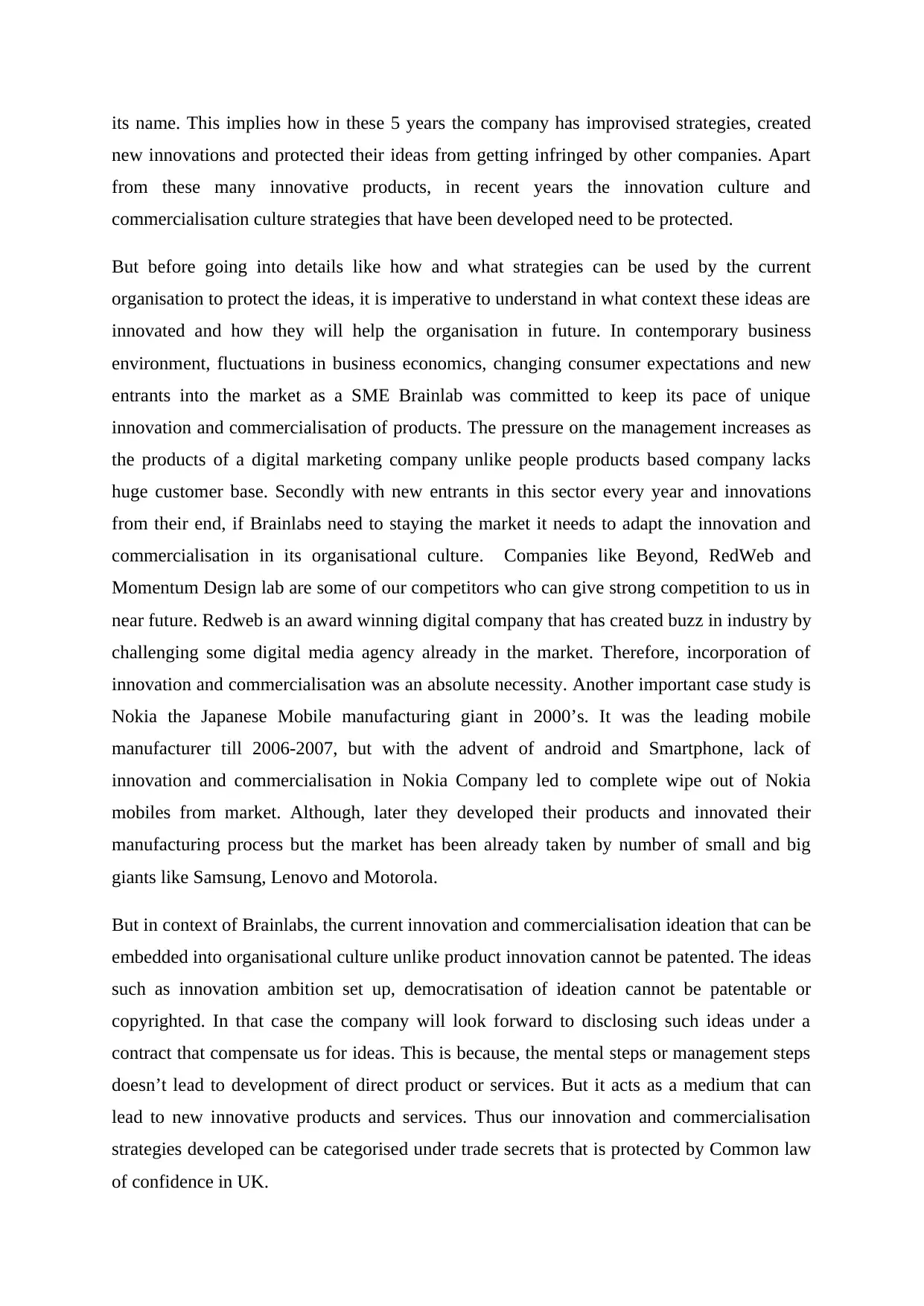
its name. This implies how in these 5 years the company has improvised strategies, created
new innovations and protected their ideas from getting infringed by other companies. Apart
from these many innovative products, in recent years the innovation culture and
commercialisation culture strategies that have been developed need to be protected.
But before going into details like how and what strategies can be used by the current
organisation to protect the ideas, it is imperative to understand in what context these ideas are
innovated and how they will help the organisation in future. In contemporary business
environment, fluctuations in business economics, changing consumer expectations and new
entrants into the market as a SME Brainlab was committed to keep its pace of unique
innovation and commercialisation of products. The pressure on the management increases as
the products of a digital marketing company unlike people products based company lacks
huge customer base. Secondly with new entrants in this sector every year and innovations
from their end, if Brainlabs need to staying the market it needs to adapt the innovation and
commercialisation in its organisational culture. Companies like Beyond, RedWeb and
Momentum Design lab are some of our competitors who can give strong competition to us in
near future. Redweb is an award winning digital company that has created buzz in industry by
challenging some digital media agency already in the market. Therefore, incorporation of
innovation and commercialisation was an absolute necessity. Another important case study is
Nokia the Japanese Mobile manufacturing giant in 2000’s. It was the leading mobile
manufacturer till 2006-2007, but with the advent of android and Smartphone, lack of
innovation and commercialisation in Nokia Company led to complete wipe out of Nokia
mobiles from market. Although, later they developed their products and innovated their
manufacturing process but the market has been already taken by number of small and big
giants like Samsung, Lenovo and Motorola.
But in context of Brainlabs, the current innovation and commercialisation ideation that can be
embedded into organisational culture unlike product innovation cannot be patented. The ideas
such as innovation ambition set up, democratisation of ideation cannot be patentable or
copyrighted. In that case the company will look forward to disclosing such ideas under a
contract that compensate us for ideas. This is because, the mental steps or management steps
doesn’t lead to development of direct product or services. But it acts as a medium that can
lead to new innovative products and services. Thus our innovation and commercialisation
strategies developed can be categorised under trade secrets that is protected by Common law
of confidence in UK.
new innovations and protected their ideas from getting infringed by other companies. Apart
from these many innovative products, in recent years the innovation culture and
commercialisation culture strategies that have been developed need to be protected.
But before going into details like how and what strategies can be used by the current
organisation to protect the ideas, it is imperative to understand in what context these ideas are
innovated and how they will help the organisation in future. In contemporary business
environment, fluctuations in business economics, changing consumer expectations and new
entrants into the market as a SME Brainlab was committed to keep its pace of unique
innovation and commercialisation of products. The pressure on the management increases as
the products of a digital marketing company unlike people products based company lacks
huge customer base. Secondly with new entrants in this sector every year and innovations
from their end, if Brainlabs need to staying the market it needs to adapt the innovation and
commercialisation in its organisational culture. Companies like Beyond, RedWeb and
Momentum Design lab are some of our competitors who can give strong competition to us in
near future. Redweb is an award winning digital company that has created buzz in industry by
challenging some digital media agency already in the market. Therefore, incorporation of
innovation and commercialisation was an absolute necessity. Another important case study is
Nokia the Japanese Mobile manufacturing giant in 2000’s. It was the leading mobile
manufacturer till 2006-2007, but with the advent of android and Smartphone, lack of
innovation and commercialisation in Nokia Company led to complete wipe out of Nokia
mobiles from market. Although, later they developed their products and innovated their
manufacturing process but the market has been already taken by number of small and big
giants like Samsung, Lenovo and Motorola.
But in context of Brainlabs, the current innovation and commercialisation ideation that can be
embedded into organisational culture unlike product innovation cannot be patented. The ideas
such as innovation ambition set up, democratisation of ideation cannot be patentable or
copyrighted. In that case the company will look forward to disclosing such ideas under a
contract that compensate us for ideas. This is because, the mental steps or management steps
doesn’t lead to development of direct product or services. But it acts as a medium that can
lead to new innovative products and services. Thus our innovation and commercialisation
strategies developed can be categorised under trade secrets that is protected by Common law
of confidence in UK.
Paraphrase This Document
Need a fresh take? Get an instant paraphrase of this document with our AI Paraphraser
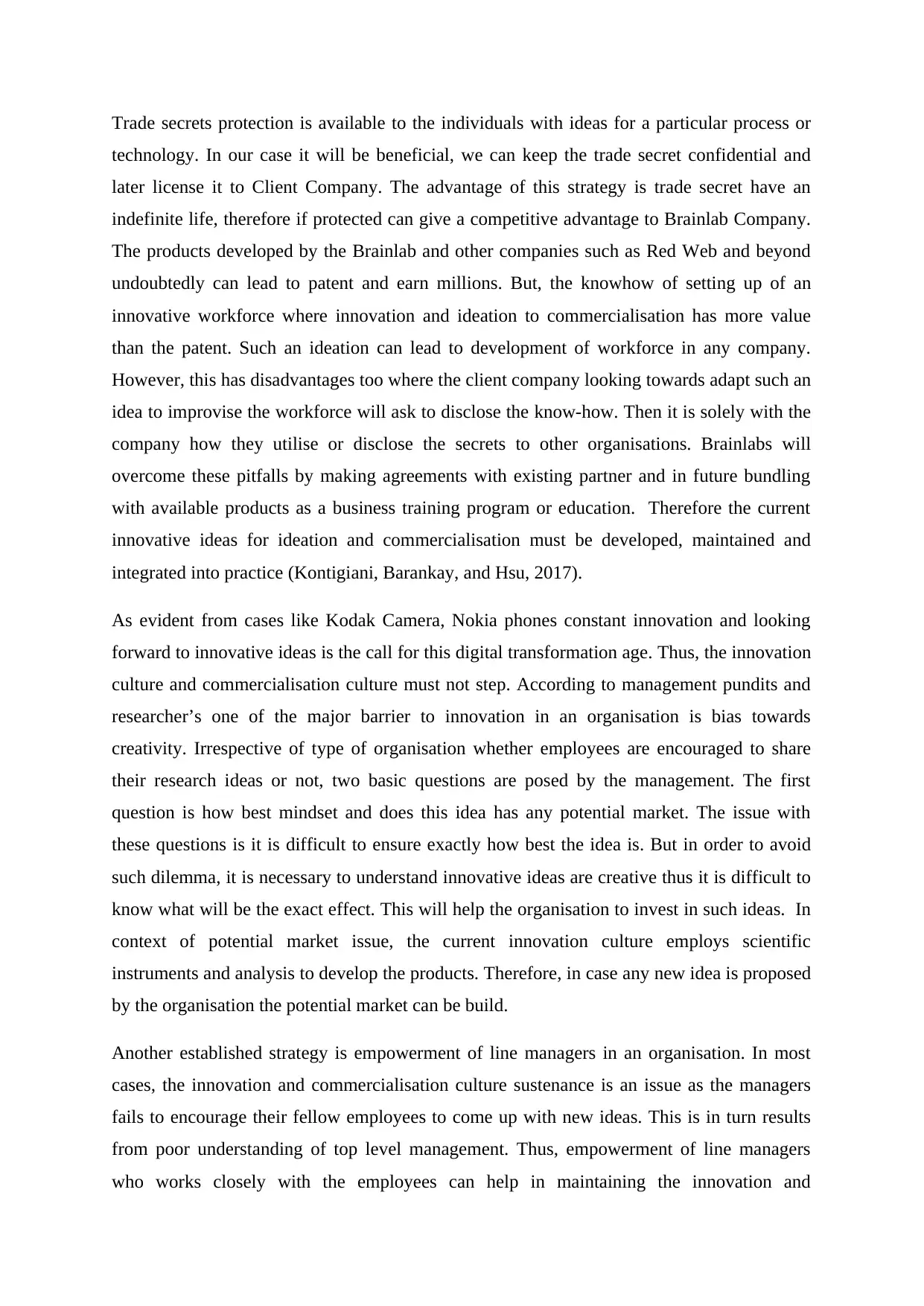
Trade secrets protection is available to the individuals with ideas for a particular process or
technology. In our case it will be beneficial, we can keep the trade secret confidential and
later license it to Client Company. The advantage of this strategy is trade secret have an
indefinite life, therefore if protected can give a competitive advantage to Brainlab Company.
The products developed by the Brainlab and other companies such as Red Web and beyond
undoubtedly can lead to patent and earn millions. But, the knowhow of setting up of an
innovative workforce where innovation and ideation to commercialisation has more value
than the patent. Such an ideation can lead to development of workforce in any company.
However, this has disadvantages too where the client company looking towards adapt such an
idea to improvise the workforce will ask to disclose the know-how. Then it is solely with the
company how they utilise or disclose the secrets to other organisations. Brainlabs will
overcome these pitfalls by making agreements with existing partner and in future bundling
with available products as a business training program or education. Therefore the current
innovative ideas for ideation and commercialisation must be developed, maintained and
integrated into practice (Kontigiani, Barankay, and Hsu, 2017).
As evident from cases like Kodak Camera, Nokia phones constant innovation and looking
forward to innovative ideas is the call for this digital transformation age. Thus, the innovation
culture and commercialisation culture must not step. According to management pundits and
researcher’s one of the major barrier to innovation in an organisation is bias towards
creativity. Irrespective of type of organisation whether employees are encouraged to share
their research ideas or not, two basic questions are posed by the management. The first
question is how best mindset and does this idea has any potential market. The issue with
these questions is it is difficult to ensure exactly how best the idea is. But in order to avoid
such dilemma, it is necessary to understand innovative ideas are creative thus it is difficult to
know what will be the exact effect. This will help the organisation to invest in such ideas. In
context of potential market issue, the current innovation culture employs scientific
instruments and analysis to develop the products. Therefore, in case any new idea is proposed
by the organisation the potential market can be build.
Another established strategy is empowerment of line managers in an organisation. In most
cases, the innovation and commercialisation culture sustenance is an issue as the managers
fails to encourage their fellow employees to come up with new ideas. This is in turn results
from poor understanding of top level management. Thus, empowerment of line managers
who works closely with the employees can help in maintaining the innovation and
technology. In our case it will be beneficial, we can keep the trade secret confidential and
later license it to Client Company. The advantage of this strategy is trade secret have an
indefinite life, therefore if protected can give a competitive advantage to Brainlab Company.
The products developed by the Brainlab and other companies such as Red Web and beyond
undoubtedly can lead to patent and earn millions. But, the knowhow of setting up of an
innovative workforce where innovation and ideation to commercialisation has more value
than the patent. Such an ideation can lead to development of workforce in any company.
However, this has disadvantages too where the client company looking towards adapt such an
idea to improvise the workforce will ask to disclose the know-how. Then it is solely with the
company how they utilise or disclose the secrets to other organisations. Brainlabs will
overcome these pitfalls by making agreements with existing partner and in future bundling
with available products as a business training program or education. Therefore the current
innovative ideas for ideation and commercialisation must be developed, maintained and
integrated into practice (Kontigiani, Barankay, and Hsu, 2017).
As evident from cases like Kodak Camera, Nokia phones constant innovation and looking
forward to innovative ideas is the call for this digital transformation age. Thus, the innovation
culture and commercialisation culture must not step. According to management pundits and
researcher’s one of the major barrier to innovation in an organisation is bias towards
creativity. Irrespective of type of organisation whether employees are encouraged to share
their research ideas or not, two basic questions are posed by the management. The first
question is how best mindset and does this idea has any potential market. The issue with
these questions is it is difficult to ensure exactly how best the idea is. But in order to avoid
such dilemma, it is necessary to understand innovative ideas are creative thus it is difficult to
know what will be the exact effect. This will help the organisation to invest in such ideas. In
context of potential market issue, the current innovation culture employs scientific
instruments and analysis to develop the products. Therefore, in case any new idea is proposed
by the organisation the potential market can be build.
Another established strategy is empowerment of line managers in an organisation. In most
cases, the innovation and commercialisation culture sustenance is an issue as the managers
fails to encourage their fellow employees to come up with new ideas. This is in turn results
from poor understanding of top level management. Thus, empowerment of line managers
who works closely with the employees can help in maintaining the innovation and
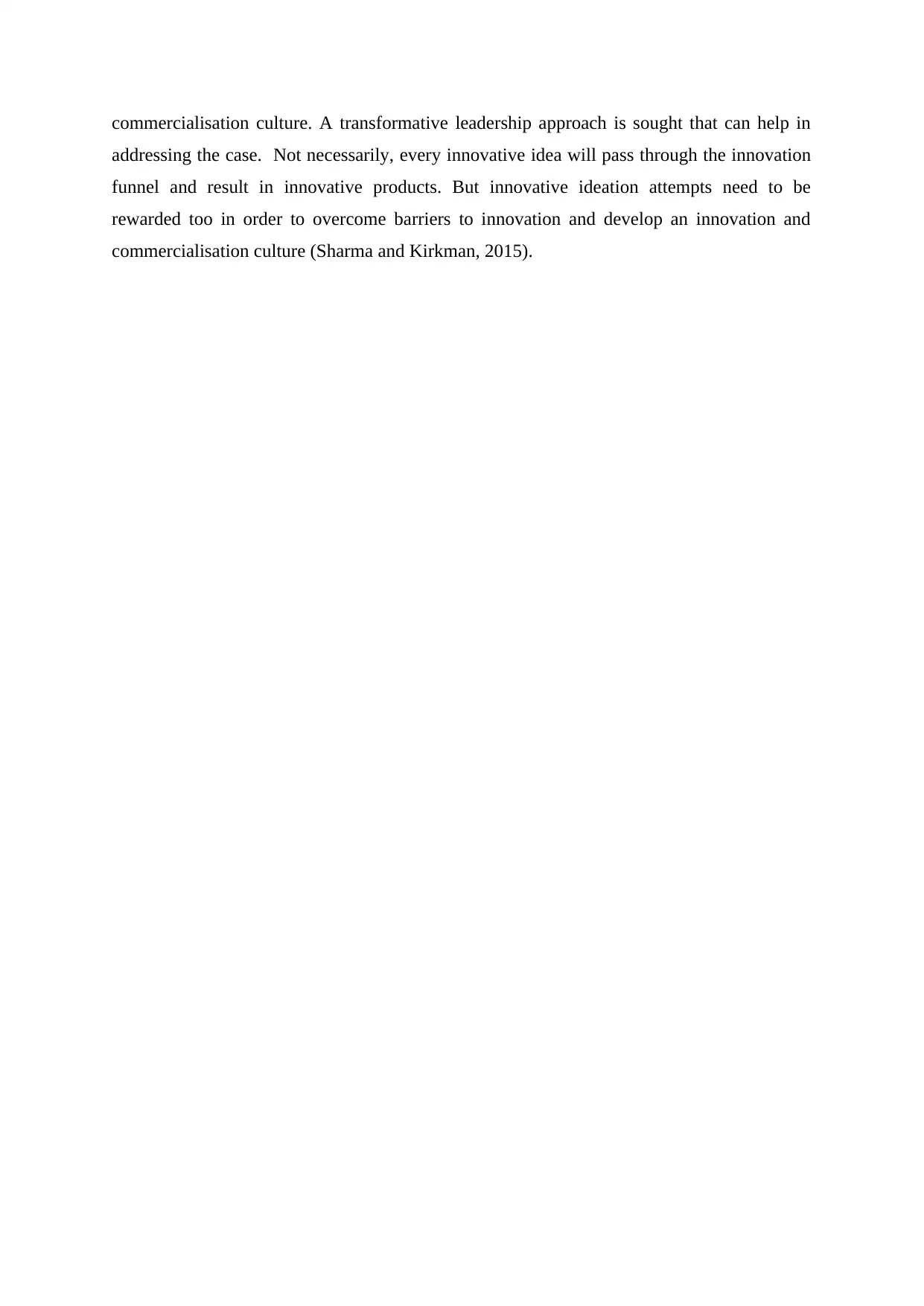
commercialisation culture. A transformative leadership approach is sought that can help in
addressing the case. Not necessarily, every innovative idea will pass through the innovation
funnel and result in innovative products. But innovative ideation attempts need to be
rewarded too in order to overcome barriers to innovation and develop an innovation and
commercialisation culture (Sharma and Kirkman, 2015).
addressing the case. Not necessarily, every innovative idea will pass through the innovation
funnel and result in innovative products. But innovative ideation attempts need to be
rewarded too in order to overcome barriers to innovation and develop an innovation and
commercialisation culture (Sharma and Kirkman, 2015).
⊘ This is a preview!⊘
Do you want full access?
Subscribe today to unlock all pages.

Trusted by 1+ million students worldwide
1 out of 15
Related Documents
Your All-in-One AI-Powered Toolkit for Academic Success.
+13062052269
info@desklib.com
Available 24*7 on WhatsApp / Email
![[object Object]](/_next/static/media/star-bottom.7253800d.svg)
Unlock your academic potential
Copyright © 2020–2025 A2Z Services. All Rights Reserved. Developed and managed by ZUCOL.





